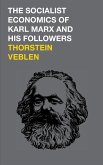Part I. Capital: Principal Features of the Marxian 'Canon': 1. Value and distribution
2. Elements of growth theory
3. Economic growth and the falling real-wage trend
4. Economic growth and the falling rate of profit
5. The cyclical dimension
Part II. Origins: Marx in the 1840s: 6. Marx's economics 1843-1845
7. A 'first draft' of Capital 1847-1849
Part III. A 'Second Draft' of Capital: The Grundrisse 1857-1858: 8. 1857-1858 I: surplus value
9. On value 'realization'
Part IV. A 'Third Draft' of Capital: The Economic Manuscripts 1861-1863: 10. 1861-1863 I: surplus value - profit, rent, and interest
11. 1861-1863 II: sectoral analysis, accumulation, and stability
12. 1861-1863 III: the labor market
Part V. Topics in Application: 13. Economic organization and the equality issue
14. Is there a Marxian 'entrepreneur'? On the functions of the industrial capitalist
15. Principles of social reform
Conclusion: a recapitulation and overview.
Part I. Capital: Principal Features of the Marxian âCanonâ: 1. Value and distribution; 2. Elements of growth theory; 3. Economic growth and the falling real-wage trend; 4. Economic growth and the falling rate of profit; 5. The cyclical dimension; Part II. Origins: Marx in the 1840s: 6. Marxâs economics 1843â1845; 7. A âfirst draftâ of Capital 1847â1849; Part III. A âSecond Draftâ of Capital: The Grundrisse 1857â1858: 8. 1857â1858 I: surplus value; 9. On value ârealizationâ; Part IV. A âThird Draftâ of Capital: The Economic Manuscripts 1861â1863: 10. 1861â1863 I: surplus value â profit, rent, and interest; 11. 1861â1863 II: sectoral analysis, accumulation, and stability; 12. 1861â1863 III: the labor market; Part V. Topics in Application: 13. Economic organization and the equality issue; 14. Is there a Marxian âentrepreneurâ? On the functions of the industrial capitalist; 15. Principles of social reform; Conclusion: a recapitulation and overview.








